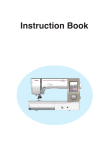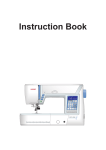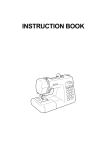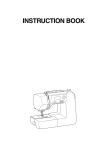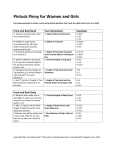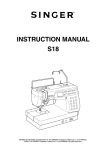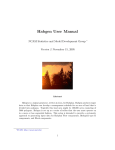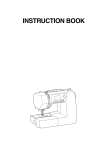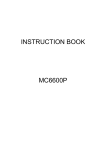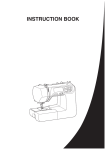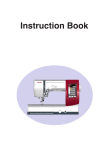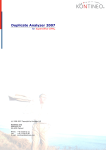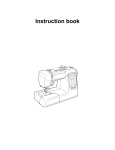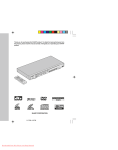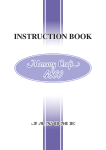Download JANOME Horizon Memory Craft 8200 QC Instruction Booklet
Transcript
Instruction Book IMPORTANT SAFETY INSTRUCTIONS This appliance is not intended for use by persons (including children) with reduced physical, sensory or mental capabilities, or lack of experience and knowledge, unless they have been given supervision or instruction concerning use of the appliance by a person responsible for their safety. Children should be supervised to ensure that they do not play with the appliance. When using an electrical appliance, basic safety precautions should always be followed, including the following: This sewing machine is designed and manufactured for household use only. Read all instructions before using this sewing machine. DANGER— To reduce the risk of electric shock: An appliance should never be left unattended when plugged in. Always unplug this sewing machine from the electric outlet immediately after using and before cleaning. WARNING— To reduce the risk of burns, fire, electric shock, or injury to persons: 1. Do not allow to be used as a toy. Close attention is necessary when this sewing machine is used by or near children. 2. Use this appliance only for its intended use as described in this owner’s manual. Use only attachments recommended by the manufacturer as contained in this owner’s manual. 3. Never operate this sewing machine if it has a damaged cord or plug, if it is not working properly, if it has been dropped or damaged, or dropped into water. Return this sewing machine to the nearest authorized dealer or service center for examination, repair, electrical or mechanical adjustment. 4. Never operate the appliance with any air opening blocked. Keep ventilation openings of this sewing machine and foot controller free from accumulation of lint, dust and loose cloth. 5. Never drop or insert any object into any opening. 6. Do not use outdoors. 7. Do not operate where aerosol (spray) products are being used or where oxygen is being administered. 8. To disconnect, turn all controls to the off (“O”) position, then remove plug from outlet. 9. Do not unplug by pulling on cord. To unplug, grasp the plug, not the cord. 10. Keep fingers away from all moving parts. Special care is required around the sewing machine needle. 11. Always use the proper needle plate. The wrong plate can cause the needle to break. 12. Do not use bent needles. 13. Do not pull or push fabric while stitching. It may deflect the needle causing it to break. 14. Switch this sewing machine off (“O”) when making any adjustment in the needle area, such as threading the needle, changing the needle, threading the bobbin or changing the presser foot, and the like. 15. Always unplug this sewing machine from the electrical outlet when removing covers, lubricating, or when making any other adjustments mentioned in this owner’s manual. SAVE THESE INSTRUCTIONS Please note that on disposal, this product must be safely recycled in accordance with relevant National legislation relating to electrical/electronic products. If in doubt please contact your retailer for guidance. (European Union only) 1 TABLE OF CONTENTS Names of Parts Names of Parts................................................................ 3 Standard Accessories..................................................... 4 Accessories Storage....................................................... 5 Extension Table............................................................... 5 Smocking....................................................................... 61 Fagoting......................................................................... 62 Scallop........................................................................... 62 Patchwork Piecing......................................................... 63 Patchwork...................................................................... 63 Quilting.......................................................................... 64 Stippling......................................................................... 65 Clasp Stitches............................................................... 65 Free Motion Quilting (1)............................................65-66 Free Motion Quilting (2)................................................. 66 Satin Stitches................................................................ 67 Twin Needle Sewing.................................................68-69 Getting Ready to Sew Connecting the Power Supply......................................... 6 Operating Instructions..................................................... 6 Machine Operating Buttons............................................. 7 Controlling Sewing Speed............................................... 8 Foot control..................................................................... 8 Function Keys.................................................................. 9 Raising and Lowering the Presser Foot........................ 10 Knee Lifter..................................................................... 10 Adjusting the Foot Pressure...........................................11 Dropping the Feed Dog..................................................11 Balancing Thread Tension............................................. 12 Lockout Key................................................................... 13 Changing the Presser Foot........................................... 13 Removing and Attaching the Foot Holder..................... 14 Dual Feed Foot..........................................................14-15 Replacing the Needle Plate........................................... 16 Changing Needles......................................................... 17 Fabric and Needle Chart............................................... 17 Winding the Bobbin....................................................... 18 Winding the Bobbin....................................................... 19 Inserting the Bobbin...................................................... 20 Threading the Machine.................................................. 21 Built-in Needle Threader............................................... 22 Drawing up the Bobbin Thread..................................... 23 Selecting the Patterns................................................... 24 Customizing Machine Settings................................. 25-27 Programming a Pattern Combination Pattern Combination...................................................... 70 Programming Auto-lock Stitch....................................... 71 Programming Automatic Thread Cutting....................... 72 Pattern Combination with a Mirror Image...................... 73 Resuming a Pattern from the Beginning....................... 74 Resuming a Pattern Combination from the Beginning.. 74 Bridge Stitches......................................................... 75-76 Monogramming.........................................................77-78 Editing a Pattern Combination....................................... 79 Deleting and Inserting a Pattern.................................... 80 Duplicating a Pattern..................................................... 80 Uniform Stitch Adjustment............................................. 81 Unified Needle Drop Position........................................ 81 Individual Stitch Adjustment.......................................... 82 Correcting Distorted Stitch Patterns.............................. 83 CARE AND MAINTENANCE Cleaning the Hook Area................................................ 84 Cleaning the Inside of the Thread Guide....................... 85 Problems and Warning Signals................................ 86-87 Troubleshooting............................................................. 88 TRADITIONAL SEWING Straight Stitch........................................................... 28-30 Sewing with the Dual Feed Device............................... 31 Dual Feed Balancing Dial.............................................. 31 Needle Plate for Straight Stitch..................................... 32 Lock-a-Matic Stitch........................................................ 32 Locking Stitch................................................................ 32 Straight Stitch with Left Needle Position....................... 33 Triple Stretch Stitch....................................................... 33 Knit Stitch...................................................................... 33 Zipper Sewing..........................................................34-36 Rolled Hem.................................................................... 37 Gathering....................................................................... 38 Pintucking...................................................................... 38 Zigzag Stitch.................................................................. 39 Multiple Zigzag Stitch (Tricot stitch).............................. 40 Overcasting Stitch......................................................... 40 Knit Stitch...................................................................... 41 Double Overcasting Stitch............................................. 41 Blind Hemming......................................................... 42-43 Shell Tuck...................................................................... 44 Buttonholes................................................................... 44 Square Buttonhole...................................................45-48 Using the Stabilizer Plate.............................................. 49 Round End and Fine Fabric Buttonholes...................... 50 Keyhole Buttonhole....................................................... 50 Stretch Buttonholes....................................................... 50 Corded Buttonhole........................................................ 51 Welted Buttonhole.................................................... 52-53 Button Sewing............................................................... 54 Darning.....................................................................55-56 Tacking.......................................................................... 57 Eyelet............................................................................. 58 Applique........................................................................ 59 Fringing.......................................................................... 60 Drawn Work.............................................................. 60-61 2 Names of Parts Names of Parts r q Thread take-up lever w Foot pressure dial e Reference chart r Top cover t Foot storage compartment y Bobbin thread cutter u Bobbin winder spindle i Hole for extra spool pin o Spool holder (large) !0 Spool pin !1 Thread tension dial !2 Face cover !3 Thread cutter !4 Extension table (accessory storage) !5 Needle plate release lever !6 Start/stop button !7 Reverse button !8 Auto-lock button !9 Needle up/down button @0 Thread cutter button @1 Speed control slider @2 Feed balancing dial @3 Knee lifter socket @4 Function keys @5LCD screen @6Needle clamp screw @7Needle @8Zigzag foot A @9Needle plate #0Hook cover release button #1Hook cover plate #2Buttonhole lever #3Needle threader #4Foot holder #5Carrying handle #6Presser foot lifter #7Handwheel #8Dual feed balancing dial #9Drop feed lever $0Power switch $1Foot control jack $2Machine socket t e y w q !1 !0 o i u @5 @4 !2 !3 !4 !5 @0 !8 !9 !7 !6 @1 @2 @3 @6 @7 #2 @8 #3 @9 #4 #0 #1 #5 NOTE: To carry the sewing machine, hold the carrying handle with your hand, and support the sewing machine with the other hand. NOTE: Sewing machine design and specifications are subject to change without prior notice. #6 #7 #8 $0 #9 $2 $1 3 q w y e u i !4 o !0 !5 !1 !2 !3 !8 !6 @0 !7 !9 @1 @2 @6 Standard Accessories t r @3 @7 @4 @8 #0 #1 #4 @5 @9 #2 #5 #3 #6 4 q Zigzag foot A (set on the machine) w Rolled hem foot D e Zipper foot E r Satin stitch foot F t Open-toe satin stitch foot F2 y Blind hemming foot G u Overcast foot M i 1/4˝ seam foot O o Darning foot PD-H !0 Convertible free motion quilting foot QB-S !1 Close-toe foot !2 Open-toe foot !3 Clear view foot !4 Automatic buttonhole foot R !5 Buttonhole stabilizer plate !6 Dual feed foot holder !7 Dual feed foot AD !8 Button sewing foot T !9 Quilting guide bar @0 Bobbin (5 pcs.) (1 set on the machine) @1 Spool holder (large, set on the machine) @2 Spool holder (small) @3 Spool supporter @4 Felt cusion @5Extra spool pin @6Needle set @7Screwdriver @8Lint brush @9Seam ripper (Buttonhole opener) #0Knee lifter #1Needle plate for straight stitch #2Touch panel stylus #3Power cable #4Foot control #5Instructional video DVD #6 Instruction book Accessories Storage The accessories can be conveniently stored in the foot storage compartment under the top cover and in the extension table. w q i e Under top cover: qZigzag foot A wOvercast foot M eZipper foot E rSatin stitch foot F tBlind hemming foot G yFoot holder uTouch panel stylus iClear view foot oOpen-toe foot !0Close-toe foot !1Convertible free motion quilting foot QB-S o r !0 t y !1 u q In extension table: qButtonhole stabilizer plate wAutomatic buttonhole foot R eNeedle plate rBobbin tPresser foot w e Other accessories can be also stored in the compartment. r t Extension Table The extension table provides an extended sewing area and can be removed for free-arm sewing. qExtension table wFree-arm w To detach: Draw the table out to the left. To attach: Slide the table on the base and push the table to the right. q Free-arm sewing Free-arm sewing is used for stitching sleeves, waistbands, pant legs or any other tubular garments. It is also useful for darning socks or mending knees or elbows. wFree-arm w 5 Getting Ready to Sew Connecting the Power Supply z First make sure the power switch q is off. x Insert the machine plug w of the power supply cord into the machine socket e. c Insert the power supply plug r into the wall outlet t, and turn the power switch q on. q Power switch w Machine plug e Machine socket r Power supply plug t Wall outlet z q c e w NOTES: Make sure to use the power supply cable that came with the machine. If you turn off the power switch, wait for 5 seconds before turning it on again. t WARNING: While in operation, always keep your eyes on the sewing area, and do not touch any moving parts such as the thread take-up lever, handwheel or needle. Always turn off the power switch and unplug the machine from the power supply: - when leaving the machine unattended. - when attaching or removing parts. - when cleaning the machine. Do not place anything on the foot control. r If you wish to use the foot control, insert the pin connector into the jack on the machine. z First make sure the power switch q is off. xInsert the pin connector w into the jack e on the machine. c Insert the machine plug r of the power supply cord into the machine socket t. v Insert the power supply plug y into the wall outlet u, and turn the power switch on. The foot control sign i will be displayed when the foot control is connected to the machine. q Power switch w Pin connector eJack r Machine plug t Machine socket y Power supply plug u Wall outlet i Foot control sign NOTE: The start/stop button does not work when the foot control is connected. z v q e w r t u y Operating Instructions: The symbol “O” on a switch indicates the “off” position of the switch. For the U.S.A. and Canada only Polarized plug (one blade wider than the other): To reduce the risk of electric shock, this plug is intended to fit in a polarized outlet only one way. If it does not fit fully in the outlet, reverse the plug. If it still does not fit, contact a qualified electrician to install the proper outlet. Do not modify the plug in any way. i 6 Machine Operating Buttons qStart/stop button Press this button to start or stop the machine. The machine starts running slowly for the first few stitches, it then runs at the speed set by the speed control slider. The machine runs slowly as long as this button is pressed. The button will turn red when the machine is running, and green when it has been stopped. Pressing and holding this button while sewing will slow down the sewing speed and the machine will stop when the button is released. NOTES: •The start/stop button cannot be used when the foot control is connected to the machine. •The machine will not run and the presser foot mark y will blink if you start the presser foot in the up position. Lower the presser foot and press the start/ stop button. •You can select the desired start-up speed from slow, medium or high (refer to page 26). t r e q w q y wReverse button When sewing stitch pattern 1, 4, 6, 7, 8, 1S, 4S (mode 1), 01, 04, 08, 09, 10 (mode 2) or 01, 02, 03, 46, 47 (mode 3), the machine will sew in reverse as long as the reverse button is pressed. If stitch pattern 1, 4, 6, 7, 8, 1S, 4S (mode 1), 01, 04, 08, 09, 10 (mode 2) or 01, 02, 03, 46, 47 (mode 3), has been selected and the foot control is not connected, the machine will start sewing in reverse as long as the reverse button is pressed. If you press the reverse button when sewing any other patterns, the machine will immediately sew locking stitches and automatically stop. w eAuto-lock button When sewing stitch pattern 1, 4, 6, 7, 8, 1S, 4S (mode 1), 01, 04, 08, 09, 10 (mode 2) or 01, 02, 03, 46, 47 (mode 3), the machine will immediately sew locking stitches and automatically stop when the auto-lock button is pressed. When sewing all other patterns, the machine will sew to the end of the current pattern, sew locking stitches and stop automatically. The machine will trim the threads automatically after locking the stitch when the auto thread cutting option is turned on. e rNeedle up/down button Press this button to bring the needle bar up or down. The machine will stop with the needle in down position. However, you can change the needle stop position in the setting mode (refer to page 26). r t Thread cutter button Press this button when you finish sewing to trim the threads. The needle bar automatically rises after trimming the threads (refer to page 29). NOTE: Use the thread cutter on the face cover if the thread is #30 or thicker (refer to page 29). t 7 Controlling Sewing Speed Speed control slider You can limit the maximum sewing speed with the speed control slider according to your sewing needs. To increase the sewing speed, move the slider to the right. To decrease the sewing speed, move the slider to the left. Foot control Pressing on the foot control can vary sewing speed. The harder you press the foot control, the faster the machine runs. NOTE: The machine runs at the maximum speed set by the speed control slider when the foot control is fully depressed. Operating Instructions: Foot control model YC-485EC-1 is for use with this sewing machine. 8 r !0 o i t e q w y u !1 !2 !3 !6 !4 !5 !7 !8 !9 @0 Function Keys q LCD screen The LCD screen shows the following information when the machine is turned on: wStitch pattern eMode rStitch pattern number tRecommended type of presser foot yStitch width uStitch length !5 Memory key (refer to pages 70) Press this key to register programmed pattern combinations. Stitch patterns in mode 2 to 6 can be Up to 50 stitch patterns combination can be memorized. !6Clear key (refer to pages 26, 80) Press the clear key to clear the memorized stitch pattern. Press and hold this key until the buzzer sounds to delete the whole pattern combination. i Cursor key (refer to pages 79, 80) Press “ ” or “ ” to move the cursor to check or edit the pattern combination. !7 Set key (refer to page 25) Press this key to enter the setting mode for customizing the machine settings. o Stitch width adjusting key (refer to pages 30, 39, 49) Press this key to alter the stitch width. !8 Elongation key (refer to page 67) !0 Stitch length adjusting key (refer to pages 30, 39, 49) Press this key to elongate satin stitch patterns. Press this key to alter the stitch length. !9 Startover key (refer to page 74) Press this key to sew a pattern combination from the !1 Mode key (refer to page 25) beginning. Press the mode key to select the mode. When the power is turned on, the direct pattern selection (mode 1) is set automatically. @0 Lockout key (refer to page 13) Press this key to lockout the machine when threading the machine, replacing the accessories etc. To reduce the risk of injury, all the buttons and keys are deactivated. To unlock the machine, press this key again. !2 Number keys (refer to page 24) •Direct pattern selection You can select the stitch patterns from 0 to 9 directly in mode 1 (direct pattern selection mode). •Numeric pattern selection Enter a 2-digit pattern number to select the desired stitch pattern in modes 2 to 6. !3 Twin needle key (refer to page 69) Press this key when sewing with a twin needle. !4 Mirror image key (refer to pages 73) Press this key to sew a mirror image of the selected pattern. 9 Raising and Lowering the Presser Foot The presser foot lifter raises and lowers the presser foot. q Presser foot lifter You can raise the presser foot higher than the normal up position. This allows for changing the needle plate, and also helps you to place thick layers of fabrics under the foot. w Extra lifted position w q NOTE: Do not turn the hand wheel of press the up/down needle button when the presser foot is in the extra lifted position. Knee Lifter The knee lifter is extremely helpful when sewing patchwork, quilting etc, since it allows you to handle the fabric while your knee controls the presser foot. e Attaching the knee lifter Match the ribs on the knee lifter with the notches in the knee lifter socket and insert the knee lifter. q Knee lifter w Rib e Knee lifter socket w q Adjusting the knee lifter The angle of the knee lifter can be adjusted to fit you. Loosen the setscrew and slide the angle bar in or out to adjust the angle of the knee lifter. Tighten the setscrew to secure the angle bar. r Setscrew t Angle bar r Using the knee lifter Push the knee lifter with your knee to easily move the presser foot up and down. You can control how high the foot rises by the amount of knee pressure you exert. t NOTE: Do not touch the knee lifter while stitching, otherwise the fabric will not be fed smoothly. 10 Adjusting the Foot Pressure The foot pressure can be adjusted with the foot pressure dial located under the top cover. q The dial has 7 setting positions from 1 to 7. For ordinary sewing, set 5 at the setting mark. q Foot pressure dial w Setting mark Reduce the pressure when sewing fine synthetics and stretch fabrics. To reduce the pressure, set the dial at a lower number. Increase the pressure when sewing heavy weight fabrics. To increase the pressure, set the dial at a higher number. w Dropping the Feed Dog The feed dog can be lowered for basting, sewing on buttons, free motion quilting etc. Shift the drop feed lever toward you to lower the feed dog. q Drop feed lever w Feed dog w Shift the drop feed lever away from you to raise the feed dog, it will return to the up position when you start the machine. q NOTE: If you start the machine with the feed dog lowered, a message will appear on the LCD screen. The machine will not run with the feed dog lowered when pattern number 19 to 25, and 27 to 29 in mode 2 or stitch patterns in modes 4, 5 and 6 is selected. 11 Balancing Thread Tension Auto-thread tension For general sewing, set the thread tension dial at AUTO, which covers a wide range of sewing conditions. q Thread tension dial NOTE: Manual thread tension adjustment may be required when the stitch width is set more than “7.0” (see below). q w Balanced thread tension For straight stitch sewing, both needle and bobbin threads will join at the middle of the fabrics. q e r w For zigzag stitch sewing, the needle thread will appear slightly on the wrong side of the fabric. q Wrong side of fabric w Right side of fabric e Needle thread r Bobbin thread q e r w Manual thread tension adjustment You should adjust the tension manually if the LCD screen shows a tension setting other than AUTO. You may also need to adjust tension manually depending on the sewing conditions such as the type of fabric and number of layers. If the needle thread is too tight, the bobbin thread appears on the right side of the fabric. q Wrong side of fabric w Right side of fabric e Needle thread r Bobbin thread Turn the thread tension dial to a lower number to decrease the thread tension. q e r w If the needle thread is too loose, the needle thread loops on the underside of the fabric. q Wrong side of fabric w Right side of fabric e Needle thread r Bobbin thread Turn the thread tension dial to a higher number to increase the thread tension. q e r 12 Lockout Key Press this key to lockout the machine when threading the machine, replacing the accessories etc. To reduce the risk of injury, all the buttons and keys are deactivated. To unlock the machine, press this key again. Changing the Presser Foot CAUTION: Always make sure to press the lockout key to lockout the machine or turn the power switch off before replacing the presser foot. q Raise the needle to its highest position and raise the presser foot lifter. Press the black lever on the back of the foot holder. The presser foot will drop off. qLever w Presser foot w Attaching the presser foot Place the presser foot so that the pin on the foot lies just under the groove of the foot holder. Lower the presser bar to lock the foot in place. Each foot is marked with an identification letter. eGroove rPin t Identification letter t e r 13 Removing and Attaching the Foot Holder q CAUTION: w Always make sure to press the lockout key to lockout the machine or turn the power switch off before replacing the presser foot. Removing the foot holder Raise the presser foot and loosen the setscrew. Remove the foot holder. e Attaching the foot holder Attach the foot holder to the presser bar from the rear. Tighten the thumbscrew securely with the screwdriver. w q q Presser bar w Foot holder eSetscrew e Dual Feed Foot z CAUTION: Always make sure to press the lockout key to lockout the machine or turn the power switch off before replacing the presser foot. q w z Raise the needle to its highest position. Raise the presser foot lifter. q Presser foot lifter wNeedle x Loosen the setscrew. Remove the foot holder. e Foot holder rSetscrew x e r 14 c Attach the dual feed foot holder to the presser bar. Tighten the setscrew lightly with your finger. t Dual feed link y Dual feed foot holder u Upper feed drive i Dual feed foot v c t u v Push the dual feed link to engage it with upper feed drive. y i b b Lower the presser foot lifter. Lower the needle to the lowest position by turning the handwheel. n n Tighten the setscrew securely with the screwdriver. Replacing the dual feed foot Pull the foot toward you to remove it. Insert the pins of the foot into the slits of the foot holder and gently push the foot until it snaps into place. qPin wSlit w q 15 Replacing the Needle Plate Use the straight stitch needle plate when sewing fine fabrics or sewing with the dual feed foot. z CAUTION: q Always make sure to press the lockout key to lockout the machine or turn the power switch off before replacing the needle plate. w z Turn the handwheel and raise the needle to the highest position. Raise the presser foot lifter to the extra lifted position. q Presser foot lifter w Needle x r x Slide the extension table to the left to remove it. Push down the needle plate release lever and the needle plate will snap off. e Needle plate release lever r Needle plate e c c Place the straight stitch needle plate on the machine. Set the left edge of the needle plate into the opening. v v Push down on the needle plate mark until the needle plate locks in place. Turn the power switch on or press the lockout key to unlock. Turn the hand wheel slowly and make sure that the needle does not hit the needle plate. t Needle plate mark t CAUTION: Never press the needle plate release lever while running the machine. 16 Changing Needles CAUTION: Always make sure to press the lockout key to lockout the machine or turn the power switch off before changing the needle. q Raise the needle by pressing the needle up/down button and lower the presser foot. Turn the power switch off. Loosen the needle clamp screw and remove the needle from the clamp. q Needle clamp screw e Insert a new needle into the needle clamp with the flat side of the needle to the rear. When inserting the needle into the needle clamp, push it up against the stopper pin and tighten the needle clamp screw firmly with a screwdriver. w Flat side e Stopper pin w To check needle straightness, place the flat side of the needle onto something flat (a needle plate, glass etc.) The gap between the needle and the flat surface should be consistent. Never use a blunt needle. rGap r Fabric and Needle Chart Fabric Thread Lawn Georgette Tricot Silk #80-100 Cotton #80-100 Synthetic #80-100 Medium Sheeting Jersey Wool Knit Silk #50 Cotton #50-80 Synthetic #50-80 Heavy weight Denim Tweed Coating Quilting Silk #30-50 Cotton #40-50 Synthetic #40-50 Fine •For general sewing, use needle size #11/75 or #14/90. •Fine threads and needles should be used for sewing fine fabrics. #9/65-11/75 •In general, use the same thread for both needle and bobbin. Blue tip needle •Use a blue tip needle for sewing fine fabrics, stretch fabrics and buttonholes to prevent skipped stitches. #11/75-14/90 •Use a purple tip needle for sewing thick fabrics, Red tip needle denims, quilt layers and across the hem to prevent skipped stitches. •Use a stabilizer or interface to stretch or fine fabrics to prevent seam puckering. #14/90-16/100 •Always test the thread and needle size on a Purple tip needle small piece of the same fabric you will use for actual sewing. Needle NOTE: 1 x twin needle, 2 x blue tip needle (#11/75), 1 x red tip needle (#14/90) and 1 x purple tip needle (#14/90) are included in the needle case. 17 Winding the Bobbin Removing the Bobbin Slide the hook cover release button to the right, and remove the hook cover plate. q Hook cover release button w Hook cover plate q Lift out the bobbin from the bobbin holder. eBobbin e w NOTE: Use the Janome plastic bobbins for horizontal hook (marked with “J” r). Using other bobbins, such as pre-wound paper bobbins, may cause stitching problems and/ or damage to the bobbin holder. r Setting the spool of thread Lift up the spool pin. Place the spool of thread on the spool pin. Attach the large spool holder, and press it firmly against the spool of thread. q Large spool holder q NOTE: Use the small spool holder to hold narrow or small spools of thread. w Small spool holder w Extra spool pin Use the extra spool pin when you need to wind a bobbin without unthreading the machine while working on a sewing project. Insert the extra spool pin into the spool supporter and then into the hole beside the horizontal spool pin. Place the felt cushion on the spool pin and place a spool of thread on it as shown. e Extra spool pin r Spool supporter t Hole for extra spool pin y Felt cushion y e r t NOTE: The extra spool pin is also used for twin needle sewing. 18 Winding the Bobbin z q z Pull the thread from the spool. Hold the thread with both hands and pass the thread into the guide slot. q Guide slot x x Draw the thread to the left and forward around the thread guide. Draw the thread to the rear and to the right around under the guide plate. Firmly pull the thread to the right while holding it with both hands. w Thread guide e Guide plate e w r cv c Pass the thread through the hole in the bobbin from the inside to the outside. Put the bobbin on the bobbin winder spindle. Push the bobbin to the right. The bobbin mark appears on the LCD screen. r Hole t Bobbin mark v Hold the free end of the thread in your hand and start the machine. Stop the machine when the bobbin has wound several layers, and cut the thread close to the hole in the bobbin. t b NOTE: Set the speed control slider at the fastest position. b Start the machine again. Stop the machine when the bobbin is fully wound and stops spinning. Return the bobbin winder spindle to its original position. Remove the bobbin and cut the thread with the thread cutter. y Thread cutter y NOTE: For safety purposes, the machine will automatically stop approximately 90 seconds after starting bobbin winding. 19 Inserting the Bobbin z z Place the bobbin in the bobbin holder with the thread running off counterclockwise. CAUTION: Always make sure to press the lockout key to lockout the machine or turn the power switch off before threading the machine. x Guide the thread into the front notch on the bobbin holder. q Front notch x q c c Draw the thread to the left, sliding it between the tension spring blades. w Tension spring blades w v v Continue to draw the thread lightly until the thread slips into the side notch. e Side notch e b Pull out about 10 cm (4˝) of thread to the rear. Reattach the hook cover plate. r Hook cover plate b NOTE: The threading chart is shown on the hook cover plate for your reference. r 20 Threading the Machine v x Raise the presser foot lifter to raise the presser foot. Turn the power switch on. Press the needle up/down button to raise the take-up lever to the highest position. Press the lockout key or turn the power switch off. Pass the thread in the order from z to m. z CAUTION: Always make sure to press the lockout key to lockout the machine or turn the power switch off before threading the machine. b c n zHold the thread with both hands and pass the thread into the guide slot. q Guide slot z m q xHold the thread with both hands and draw the thread around the corner of the guide. Firmly pull the thread toward you along the right channel until the thread snaps. w Corner of the guide e Right channel w x e e c cDraw the thread down along the right channel and around the bottom of the thread guide plate. Pull the thread up along the left channel. e Right channel r Thread guide plate t Left channel v y t vWhile holding the thread at the spool, firmly draw the thread up and to the back of the take-up lever. Draw the thread forward to slip it into the eye of the take-up lever. y Eye of the take-up lever r bThen pull the thread down along the left channel and through the lower thread guide. u Lower thread guide bnm u nSlide the thread behind the needle bar thread guide on the left. i Needle bar thread guide i mThread the needle with the needle threader (refer to the next page). 21 Built-in Needle Threader z NOTES: •The needle threader can be used with a #11 to #16 needle. Thread size 50 to 90 is recommended. •The needle threader cannot be used with the twin needle. q CAUTION: Always make sure to press the lockout key to lockout the machine or turn the power switch off before using the built-in needle threader. w z Turn the power switch ON. Press the needle up/down button to raise the needle. Press the lockout key to lock the machine. Pull down the needle threader knob as far as it will go. The threader hook comes out through the needle eye from behind. q Needle up/down button w Threader knob e Threader hook e x Draw the thread from left to right, under the left guide, threader hook and right guide. Draw the thread around the right guide toward you. r Left guide t Right guide x r t c cRaise the threader slowly so a loop of the thread is pulled up through the needle eye. y Threader loop y vRemove the thread end through the needle eye to the rear. v NOTE: The needle threader cannot be used with the twin needle. 22 Drawing up the Bobbin Thread z Raise the presser foot lifter. Hold the needle thread with your finger. q Needle thread z q x Press the needle up/down button twice to draw up the bobbin thread. w Needle up/down button x w c Pull the needle thread to bring up the loop of bobbin thread. e Loop of bobbin thread c e v Pull both threads 10 cm (4˝) and draw them to the rear under the presser foot. v 23 Selecting the Patterns Mode 1 You can select the following stitch patterns directly by pressing the pattern keys. q Pattern keys (Number keys) e w q Example: To select stitch pattern 4 in mode 1 When the power switch is turned on, the direct stitch pattern selection (mode 1) is set automatically. Press the pattern key 4 to select the stitch pattern 4. Now pattern 4 (mode 1) is selected. Mode 2 – 6 To select stitch patterns in modes 2–6, first press the mode key w to select your desired mode. Each time you press the mode key, the mode number e indicated on the left side of the screen will change, and the mode changes as follows, Mode 1: Mode 2: Mode 3: Mode 4: Mode 5: Mode 6: z e Direct pattern selection Utility stitch pattern selection Decorative stitch pattern selection Number and letter selection European accented letter selection 9 mm monogram selection Example: To select stitch pattern 53 in mode 3 z Turn the power switch on. Press the mode key twice to select mode 3. x x Press the number keys on the touch panel. First press key 5 and then press key 3. c c Now pattern 53 in mode 3 is selected. 24 Customizing Machine Settings e r q You can customize the machine settings to your preference. Press the set key q and LCD screen will show the setting mode. Press the mode key w to select the desired setting. In this mode, you can set the following machine functions. w e Buzzer sound setting r Needle stop position setting t Start up speed setting y Resetting all to default u Key position calibration To exit the setting mode, press the set key q. t y u Buzzer sound setting The buzzer sound can be turned on or off using the buzzer sound setting. The default buzzer sound setting is “ON”. Enter the setting mode. To turn off the buzzer sound, press the cursor key “ ” and the “oF” mark will blink. To turn on the buzzer sound, press the cursor key “ ” and the “on” mark will blink. 25 Needle stop position setting The machine always stops with the needle in the down position except when sewing buttonholes, specialty stitches, monograms, etc. However you can select the needle stop position to up or down. Enter the setting mode. Press the mode key to enter the needle stop position setting. The default needle stop position setting is down position “dn”. To change the needle stop position, press the cursor key “ ” and the “UP” mark will blink. Start-up speed setting q The machine will start running slowly and the sewing speed will gradually increase to maximum when pressing the start/stop button. You can select the desired start-up speed from 1 (slow) q, 2 (medium) w or 3 (high) e. w Enter the setting mode. Press the mode key twice to enter the start-up speed setting. The default start-up speed setting is “1” (slow). To change the start-up speed, press the cursor key “ ” or “ ”, and the selected speed number will blink. e Resetting all to default The following customized settings can be reset to the original settings (factory settings). •Buzzer sound •Needle stop position •Start up speed setting Enter the setting mode. Press the mode key 3 times to enter the Resetting all to default mode. Press and hold the clear key until the machine beeps to reset the machine to the factory default setting. 26 Key position calibration z x If the function keys seem out of alignment, calibrate the key position as follows. z Enter the setting mode. Press the mode key 4 times to enter the key position calibration. x Press the start/stop button q. q r (t2) y (t4) t (t3) u (t5) e (t1) w c c The key position adjustment screen appears and “t1” is shown on the right side of the screen. With the touch panel stylus w, press e on the touch panel of your machine. v v “t2” will be shown on the LCD screen. Press r on the touch panel. b b “t3” will be shown on the LCD screen. Press t on the touch panel. n n “t4” will be shown on the LCD screen. Press y on the touch panel. m m “t5” will be shown on the LCD screen. Press u on the touch panel. , , The screen will be back to the key position adjustment screen. Press the set key to apply the adjustment. 27 q e TRADITIONAL SEWING w Straight Stitch Machine settings q Pattern: w Thread tension: e Presser foot: r Foot pressure: r MODE 1: 1, 1S MODE 2: 01 AUTO Zigzag foot A or Dual feed foot AD 5 Starting to sew Raise the presser foot and position the fabric edge next to a seam guide on the needle plate. Lower the needle at the point where you wish to start. Pull the needle and bobbin threads toward the rear. Lower the presser foot. NOTE: Pull the needle and bobbin threads to the left when using satin stitch foot F or automatic buttonhole foot R. Depress the foot control or press the start/stop button to start sewing. Gently guide the fabric along the seam guide letting the fabric feed naturally. Securing seams For fastening the ends of seams, press the reverse button and sew several reverse stitches. The machine sews in reverse as long as you press and hold the reverse button. q Reverse button Press the reverse button once when sewing the lock-a-matic stitch (pattern 2) or locking stitch (pattern 3) and the machine will lock the stitches off and stop automatically. q q Sewing from the edge of thick fabric The black button on the zigzag foot locks the foot in the horizontal position. This is helpful when you start sewing from extreme edge of thick fabrics or sewing across a hem. Lower the needle into the fabric at the point where you wish to start sewing. Lower the foot while pushing the black button in. The foot is locked in the horizontal position to avoid slipping. w q Thick fabrics w Black button Changing sewing direction Stop the machine. Raise the presser foot. Pivot the fabric around the needle to change the sewing direction as desired. Lower the presser foot and start sewing in a new direction. 28 Cutting threads To cut the threads after finishing sewing, press the thread cutter button. The needle bar will automatically go up after trimming the threads. q Thread cutter button q NOTES: The thread cutter button does not function when the presser foot is up. Use the thread cutter on the face cover to cut specialized or thick threads if the auto thread cutter does not work well. w r To use the thread cutter on the face cover, remove the fabric and draw it to the back. Pull the threads up and slip them between the thread cutter and face cover from behind. Pull the threads toward you to cut. w Thread cutter Needle plate guides The seam guides are marked on the needle plate, free arm and hook cover. The seam guides for 1/4˝, 3/8˝ and 5/8˝ are also marked on the front of the needle plate. q Seam guides on the front of the needle plate The numbers on the needle plate indicate the distance from the center needle position in millimeters and inches. w Center Needle Position The cornering guides are very useful when turning a square corner. e Cornering guide The angle scales on the needle plate are useful for patchwork piecing. r Angle scales w e q Cornering guide To maintain a 5/8˝ seam allowance after turning a square corner, use the cornering guide on the needle plate. Stop sewing when the front edge of fabric reaches the cornering guide lines. 5/8˝ Raise the presser foot and turn the fabric 90 degrees. Lower the presser foot, and begin stitching in the new direction. q Cornering guide w Fabric edge w q 29 Adjusting the needle drop position The needle drop position of the straight stitches can be altered by pressing the stitch width adjusting key. The needle drop position can be adjusted for following straight stitch patterns: Mode 1: Mode 2: Mode 3: 0.0 4.5 9.0 Press the “ ” sign on the stitch width adjusting key to move the needle bar to the right. Press the “ ” sign on the stitch width adjusting key to move the needle bar to the left. Adjusting the stitch length The stitch length can be altered by pressing the stitch length adjusting key. The stitch length indication will change as the key is pressed. Press the “ length. Press the “ length. 1.00 2.40 5.00 30 ” sign on the key to increase the stitch ” sign on the key to decrease the stitch Sewing with the Dual Feed Device The following stitch patterns can be sewn with the dual feed device. Mode 1 Mode 2 Mode 1: 1, 2, 3, 4, 8, 1S, 2S, 3S, 4S Mode 2: 01, 02, 03, 04 Mode 3: 01, 02, 03, 04 Mode 3 The dual feed device is extremely effective for sewing with hard to feed material such as vinyl or leather. It also eliminates layer slippage. NOTE: See page 14–15 for how to attach the dual feed foot and to engage the dual feed device. Sewing Raise the presser foot and position the fabric edge next to a seam guide on the needle plate. Lower the needle at the point where you wish to start. Pull the needle and bobbin thread toward the rear. Lower the presser foot. Start sewing at medium speed. Gently guide the fabric along the seam guide letting the fabric feed naturally. When seaming plaid fabrics, match the plaids of the upper and lower layers and pin them together. Dual Feed Balancing Dial The dual feed balancing dial should be set at “0”. However, you may need to adjust the dual feed balance with this dial since the effect of the dual feed varies depending on the type of fabric. Test sew on scrap piece of the fabric you intended to sew to check the feed balance. (A): If the lower layer puckers, turn the dual feed balancing dial toward “+”. (B): If the upper layer puckers, turn the dual feed balancing dial toward “–”. q Dual feed balancing dial w Upper layer e Lower layer q (A) w Set the feed balancing dial to “0” after the dual feed sewing. NOTE: Reducing the foot pressure will also improve the feed balance. e (B) w e 31 Needle Plate for Straight Stitch The stitch patterns 1, 2, 3, 4 (mode 1) can be sewn with the needle plate for straight stitch. w Mode 1: Replace the needle plate with the needle plate for straight stitch (refer to page 16). “S” mark will appear at the end of the pattern number when the needle plate for straight stitch is attached. q Needle plate for straight stitch w S mark q q e Lock-a-Matic Stitch w Machine settings q Pattern: w Thread tension: e Presser foot: r Foot pressure: r MODE 1: 2, 2S MODE 2: 02 AUTO Zigzag foot A or Dual feed foot AD 5 Use this stitch to secure the beginning and the end of a seam with backstitching. When you reach the end of the seam, press the reverse button q once. The machine will sew four reverse stitches, four forward stitches, and then stop sewing automatically. q Reverse button q q e Locking Stitch w Machine settings q Pattern: w Thread tension: e Presser foot: r Foot pressure: r MODE 1: 3, 3S MODE 2: 03 AUTO Zigzag foot A or Dual feed foot AD 5 This unique stitch is used where an invisible locking stitch is needed. Lower the needle close to the front edge of the fabric. The machine will sew several locking stitches in place and continue sewing forward. When you press the reverse button q at the end of the seam, the machine will sew several locking stitches in place, then stop sewing automatically. q Reverse button q 32 q e Straight Stitch with Left Needle Position w Machine settings q Pattern: w Thread tension: e Presser foot: r Foot pressure: r MODE 1: 4, 4S MODE 2: 04 AUTO Zigzag foot A or Dual feed foot AD 5 Use this stitch to seam the edge of fabrics. q e Triple Stretch Stitch w Machine settings q Pattern: w Thread tension: e Presser foot: r Foot pressure: r MODE 1: 5 MODE 2: 05 AUTO Zigzag foot A 5 This strong, durable stitch is recommended for areas where both elasticity and strength are needed to ensure comfort and durability. Use it to reinforce areas such as crotch and armhole seams. Also use it when constructing items such as backpacks for extra strength. q e Knit Stitch w Machine settings q Pattern: w Thread tension: e Presser foot: r Foot pressure: r MODE 2: 06 or 07 AUTO Zigzag foot A 4 This is a narrow stretch stitch designed to eliminate puckering on knit fabrics and bias seams, while permitting the seam to be pressed completely open flat. Use this stitch when seaming thin fabrics such as tricot and fine jersey. Stitch pattern 07 (mode 2) is a stretch stitch in the left needle position. 33 q e Zipper Sewing w Machine settings q Pattern: w Thread tension: e Presser foot: r Foot pressure: r MODE 1: 1 MODE 2: 01 AUTO Zipper foot E Zigzag foot A 5 NOTE: The needle drop position should be adjusted when sewing with the zipper foot E. Fabric preparation Add 1 cm (3/8“) to the zipper size. This is the overall opening size. q Right sides of the fabric w 1 cm (3/8“) e Opening size r Zipper size t End of the zipper opening t e r q w o Place the right sides of the fabric together and sew to the end of the opening with a 2 cm (5/8˝) seam allowance. Reverse stitch to lock the seams. Manually increase the stitch length to 5.0 and baste the zipper opening with the thread tension loosened to 1-3. t End of the zipper opening y 2 cm (5/8“) seam allowance u Basting i Reverse stitches o Seam stitches i t u y 34 Sewing z Fold back the left seam allowance. Turn the right seam allowance under to form a 0.2 to 0.3 cm (1/8˝) margin. Place the zipper teeth next to the fold and pin in place. Set the stitch length and thread tension back to the original setting. q 0.2 to 0.3 cm (1/8˝) margin w Zipper teeth eFold r End of the zipper opening t Opening size z r w q t e x Attach the zipper foot. Adjust the stitch width to 7.5–8.5. Lower the foot onto the topside at the end of the zipper opening so that the needle pierces the fabric next to the fold and the zipper tape. Sew along the zipper guiding the zipper teeth along the side edge of the foot. x CAUTION: Be sure that the needle do not strike the presser foot or zipper teeth when the zipper foot is attached and stitch width is adjusted. c Sew through all layers next to the fold. Stop 5 cm (2˝) before zipper foot E reaches the slider on the zipper tape. Lower the needle slightly into the fabric. Raise the foot and open the zipper to clear the slider. Lower the foot and stitch the remainder of the seam. ySlider u 5 cm (2˝) c y u 35 v Close the zipper and spread the fabric open flat with the right side facing up. Attach the Zigzag foot A. Adjust the stitch length to 5.0, stitch width to 4.5 (default value) and thread tension dial to 1. Baste the opened fabric and zipper tape together. iBasting o Zipper tape v i o b Attach the zipper foot E. Adjust the stitch length to default value, stitch width to 0.5–1.5, thread tension dial to “AUTO”. Backstitch across the end of the opening 0.7-1 cm (3/8˝) and turn the fabric 90 degrees. !0 0.7-1 cm (3/8˝) b n CAUTION: !0 Be sure that the needle do not strike the presser foot or zipper teeth when the zipper foot is attached and stitch width is adjusted. !1 !2 n Stitch through the garment and zipper tape, guiding the zipper teeth along the side edge of the foot. Stop about 5 cm (2˝) from the top of the zipper. Unfasten the basting stitches. Lower the needle into the fabric, raise the foot, and open the zipper. !1 5 cm (2˝) !2 Basting stitches m Lower the foot and stitch the remainder of the seam, making sure the fold is even. Remove the basting threads after seaming. m 36 q e Rolled Hem w Machine settings q Pattern: w Thread tension: e Presser foot: r Foot pressure: r Sewing z Fold the edge of the fabric twice, 6 cm (2 - 3/8˝) in length and 0.3 cm (1/8˝) in width. q 6 cm (2 - 3/8˝) w 0.3 cm (1/8˝) z w MODE 1: 1 MODE 2: 01 AUTO Rolled hem foot D 5 q x Place the fabric aligning the edge of the hem with the guide on the foot. Lower the foot and sew 1-2 cm (1/2˝-1˝) while pulling both thread to the back. eThreads x e c Stop the machine and lower the needle into the fabric. Raise the foot and insert the folded portion of the fabric into the curl of the foot. Lower the foot, and then sew by lifting up the edge of the fabric to keep it feeding smoothly and evenly. r Curl of the foot c r NOTE: Trim the corner 0.6 cm (1/4˝) to reduce bulk. t 0.6 cm (1/4˝) 0.6 cm t 0.6 cm 37 q e Gathering w Machine settings q Pattern: w Thread tension: e Presser foot: r Foot pressure: r MODE 1: 1 MODE 2: 01 1 Zigzag foot A 5 Loosen the thread tension to “1” and increase the stitch length to 5.0. 0.6 cm NOTE: Pull up the bobbin thread and draw a 10 cm (4˝) thread tail to the back before starting to sew. Use the thread cutter on the face plate. Sew two rows of straight stitches 0.6 cm (1/4˝) apart. Knot the threads at the beginning. Pull the bobbin threads at the end to gather the fabric. Knot the threads at the end and distribute the gathers evenly. q e Pintucking w Machine settings q Pattern: w Thread tension: e Presser foot: r Foot pressure: r MODE 1: 4 MODE 2: 04 AUTO Blind hem foot G 5 Fold the fabric with the wrong sides together. Place the folded fabric under the blind hem foot. Align the edge of the fold with the guide on the foot, and lower the foot. Sew while guiding the edge of the fold along the guide. Open the fabric and press the tuck to one side. 38 q e Zigzag Stitch w Machine settings q Pattern: w Thread tension: e Presser foot: r Foot pressure: r MODE 1: 6, 7 MODE 2: 08, 09 AUTO Zigzag foot A 5 Zigzag stitch is used for various sewing needs including overcasting. It can be used on most woven fabrics. A dense zigzag stitch can also be used for applique. Adjusting the stitch length The stitch length of the zigzag stitches can be altered by pressing the stitch length adjusting key. Press the “ ” sign on the stitch length adjusting key to increase the stitch length. Press the “ ” sign on the stitch length adjusting key to decrease the stitch length. q Stitch length q Adjusting the stitch width The stitch width of the zigzag stitches can be altered by pressing the stitch width adjusting key. Press the “ ” sign on the stitch width adjusting key to increase the stitch width. Press the “ ” sign on the stitch width adjusting key to decrease the stitch width. q Stitch width (A) (B) (A): The pattern number 6 (mode 1) or 08 (mode 2) has a fixed center needle drop position. The stitch width changes symmetrically. (B): The pattern number 7 (mode 1) or 09 (mode 2) has a fixed right needle drop position. When you change the stitch width, the left needle drop position will change. w Fixed right needle position w q 39 q e Multiple Zigzag Stitch (Tricot stitch) w Machine settings q Pattern: w Thread tension: e Presser foot: r Foot pressure: r MODE 2: 10 AUTO Zigzag foot A 5 This stitch is used to finish a raw edge of synthetics and other stretch fabrics that tend to pucker. Sew along the fabric edge leaving an adequate seam allowance. After sewing, trim the seam allowance close to the stitches. q e Overcasting Stitch w Machine settings q Pattern: w Thread tension: e Presser foot: r Foot pressure: r MODE 2: 11 AUTO Overcast foot M 5 This stitch can be used to simultaneously seam and overcast edges of fabrics. Use this stitch when you do not need to open seams flat. Place the fabric edge next to the guide of the foot and then sew. q Edge of fabric w Guide NOTE: The stitch width cannot be changed. w q 40 q e Knit Stitch w Machine settings q Pattern: w Thread tension: e Presser foot: r Foot pressure: r MODE 2: 12 AUTO Overcast foot M 4 This stitch is recommended for sewing such fabrics as synthetic knits and stretch velour as it provides the greatest amount of elasticity and strength. Place the fabric edge next to the guide of the foot and then sew. q Edge of fabric w Guide NOTE: The stitch width cannot be changed. w q q e Double Overcasting Stitch w Machine settings q Pattern: w Thread tension: e Presser foot: r Foot pressure: r MODE 2: 13 AUTO Overcast foot M 5 This is an excellent stitch for fabrics that tend to fray extensively such as linens and gabardines. Two rows of zigzag stitches are simultaneously sewn over the edge to insure that fabric will not ravel. Place the fabric edge next to the guide of the foot and then sew. q Edge of fabric w Guide NOTE: The stitch width cannot be changed. w q 41 q e Blind Hemming w Machine settings q Pattern: w Thread tension: e Presser foot: r Foot pressure: r q Select pattern 14 for woven fabrics or pattern 15 for elastic fabrics. w e e t MODE 2: 14, 15 AUTO Blind hemming foot G 5 Folding the fabric Fold the fabric to make a hem as shown. q Heavy fabric w Fine to medium fabric e 0.4 – 0.7 cm (3/16˝–1/4˝) r Overcasting t Wrong side of fabric t r Sewing Position the fabric so that the fold comes to the left side of the guide on the foot. Lower the presser foot. Adjust the position of the needle swing with the stitch width adjusting key so that the needle just pierces the folded edge of the fabric when the needle comes over to the left side. y u Sew guiding the fold along the guide. y Guide on the foot u Fold Open the fabric with the right side up. The stitches on the right side of the fabric will be almost invisible. i Right side of fabric i 42 Changing the needle drop position Press the stitch width adjusting key. The LCD screen shows the distance between the left needle position and the guide in millimeters r. r Press the “ ” sign to move the needle to the right. Press the “ ” sign to move the needle to the left. q Left needle drop position w Right needle drop position e Guide on foot r Distance between the left needle position and the guide e r NOTE: The stitch width of patterns 14 (mode 2) and 15 (mode 2) cannot be changed, but the needle drop position will move. q w → ← Making the straight stitches in pattern number 14 longer Program a combination of patterns 14 (mode 2) and pattern 48 (mode 3). Two straight stitches will be added to the blind hem stitch when combining with pattern 48 (mode 3) q (Refer to page 75). q 43 q e Shell Tuck w Machine settings q Pattern: w Thread tension: e Presser foot: r Foot pressure: r MODE 2: 16 6−8 Satin stitch foot F 5 Use a light weight fabric (tricot, for example). Fold the fabric as shown and stitch on the fold. Allow the needle to just clear the folded edge to create a shelled edge. You may need to increase the needle thread tension. q Folded edge w Right needle drop position If you sew rows of shell stitches, space the rows at least 1.5 cm (5/8˝) apart. You can also sew shell stitches on knits or soft silky woven fabrics in any direction. w q Buttonholes Variety of buttonholes 19 Square buttonhole This square buttonhole is widely used on medium to heavy weight fabrics. The buttonhole size is automatically determined by placing a button in the foot. 20 Round end buttonhole This buttonhole is used on fine to medium weight fabrics especially for blouses and children’s clothes. 21 Fine fabric buttonhole This buttonhole is rounded at both ends and is used on fine, delicate fabrics such as fine silk. 22 Keyhole buttonholes The Keyhole Buttonhole is widely used on medium to heavy weight fabrics. It is also suitable for larger and thicker buttons. 23-24 Stretch buttonholes This buttonhole can be used on stretch fabrics. It can also be used as a decorative buttonhole. 25 Welted buttonhole This is a template pattern for the hand sewn welted (bound) buttonhole. NOTE: Sewing procedure of patterns 20-25 is the same as pattern number 19. 44 q e Square Buttonhole w Machine settings q Pattern: w Thread tension: e Presser foot: r Foot pressure: r MODE 2: 19 AUTO Automatic buttonhole foot R 5 The size of a buttonhole is automatically set by placing a button in the rear of automatic buttonhole foot R. The button holder of the foot takes a button size of 1 cm (3/8˝) to 2.5 cm (1˝) in diameter. When selecting the buttonholes, the LCD screen advise you to lower the buttonhole lever. z q NOTES: It is sometimes necessary to change buttonhole size to match certain heavy or specific fabrics and threads. Make a test buttonhole on an extra piece of the fabric to check your settings. The preset width of the buttonhole is suited for ordinary buttons. Apply an interfacing to stretch or fine fabrics. w x Sewing z Press the needle up/down button to raise the needle. Attach the automatic buttonhole foot R snapping the pin into the groove of the foot holder. You may lift the presser foot lifter to the extra lifted position when placing the automatic buttonhole foot under the foot holder. qGroove wPin e x Pull the button holder to the back, and place the button in it. Push it together tightly on the button. e Button holder c Pull the buttonhole lever down as far as it will go. r NOTES: Check the length of the test buttonhole, and adjust the buttonhole length if necessary by turning the adjusting screw on the buttonhole foot. To increase the buttonhole length, turn the adjusting screw to move the marker toward “L”. To decrease the buttonhole length, turn the adjusting screw to move the marker toward “S”. r Adjusting screw t Marker t y Buttonhole lever c y 45 v Mark the buttonhole position on the fabric and place it under the buttonhole foot. Lower the needle at the starting point by turning the hand wheel. u Starting point v u NOTE: Make sure there is no gap between the slider and front stopper, otherwise the buttonhole will be out of position or there will be a sewing gap. i No gap o Starting point !0 Sewing gap i !0 !0 o !0 o o b Start sewing while pulling the needle thread lightly to the left. After sewing a few stitches, free the thread and continue sewing. b 46 n The buttonhole is sewn automatically in the sequence shown. When the buttonhole is finished, the machine will stop automatically with the needle in the up position. Press the thread cutter button and remove the fabric. n NOTE: If you start sewing without pulling down the buttonhole lever, the LCD screen will show a warning and the machine will stop after a few stitches. Pull the buttonhole lever down and start sewing. m m After you finish buttonhole sewing, push the buttonhole lever up as far as it will go. , , Place a pin just below the bartack at each end to prevent accidentally cutting the threads. Cut the opening with the seam ripper. Use an eyelet puncher to open a keyhole buttonhole. NOTE: To make a solid and sturdy buttonhole, sew another layer of buttonhole over the previous one. After the buttonhole is finished, simply press the start/ stop button again. Do not raise the foot or reselect the pattern. The machine will sew another buttonhole over the previous one. 47 Manual settings The buttonhole width can be adjusted by pressing the stitch width adjusting key. Press the “ ” sign on the stitch width adjusting key to increase the buttonhole width. Press the “ ” sign on the stitch width adjusting key to decrease the buttonhole width. q Stitch width adjusting key w Narrower buttonhole e Wider buttonhole q NOTE: The buttonhole width can be adjusted from 2.5 to 7.0. w e Adjusting the buttonhole stitch density The buttonhole stitch density can be adjusted by pressing the stitch length adjusting key. Press the




























































































